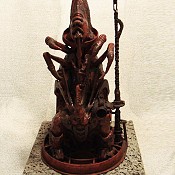Eduardo Martín is a graphic designer from Mendoza (Argentina) and he has been working with Fantastic Art for 20 years.
In 1994 he created with Alejandro Semiz the collective project "EMPTY TRASH", which became later an individual project of Eduardo Martín.
His works include sculptures, objects and three-dimensional paintings; covering a range of fantastic creatures from various inspiring sources: sometimes books by different authors, sometimes self-created myths.
His love for fantasy and science fiction led him to observe and discover in the waste and the trash an universe of shapes that became the main raw material for his art. An art that is created following self-created techniques. The aesthetics he works with, as much as the themes he chooses, are loaded with symbolism and subliminal messages.
Contact: emptytrashartefantastico@gmail.com
"The Bishops" Series
These five works were created in 2011 and they were made from recycled materials of all kinds through the technique of mixed assemblage. They belong to the series of sculptures HISTORIAS DE GENOMA.
AESTHETICS AND GENERAL SYMBOLISM: These works represent biomechanical entities that were created by the "Supreme" to direct and govern every continent as a monarchy , to bring each region to a specific development in the "Great Factory", a name given by the Supreme to our world under the dominion of the "New Religion" ...
Some aspects in common among the five sculptures is that they are all dressed in an Elizabethan collar, a symbol of their lineage, all of them have a monarchical wand, a symbol of their power and all have an elongated hat, a symbol of their ecclesiastical hierarchy and their "divine" mission.

This work contains symbologies which are related to different Eastern cultures, such as the ceramic mask-like face, the katana and the spear used as a scepter. In this Figure, the mechanical parts dominate over the organic ones. The Bishop of Asia is the only one that was represented without legs, only the head and the hands, so indispensable to handle the technology. The overall look is meant to allude to the technological atmosphere, but it also keeps references to ancestral codes. The color and texture of this work refers to certain types of semi-precious stones which are used for carving some totems. The overall look of this piece is a reference to the "priestly" and the mystical atmosphere of Oceania. The staff of this bishop is also a great "harpoon", a fundamental tool in many oceanic cultures for hunting and fishing. The spirals and scrolls are shown as expressions of fertility and transcendence. The face of the Bishop is a direct reference to the aesthetic "TItem", used in Oceania to represent both gods and demons. AMERICA (the trainer continent) The appearance of this bishop is inspired by the shamanistic clothes of the pre-Columbian cultures. A more comtemporanea reference is the weapon, a guerrilla machine-gun, a representation of many current realities of America. The rod of this bishop does not symbolize or represent anything other than itself, just a staff, an element that is always associated with magical properties. The mask-helmet on his face gives the character the look of a warrior. A typical American sculptural representation is the phallic shape, a reference that is also shown here. Organic and chemical elements are found here in a univocal representation through the aesthetics of an "insect". The scepter of this being is like the wand of the witches, a wand that means that he's the "doctor of the tribe", made with bones and horns. The color of this work was also chosen to enhance the aggressive and threatening look. Spikes and thorns as phallic representations, symbols of inoculation and transformation of life. Mutation. Europe, the continents that is completely open to genetic research and genetic development. The concepts of observation and investigation are taken as a weapon. The aesthetics of this Bishop bring the Gothic style syncretized with the power of heavy machinery in an old industrial fashion, with a scent that smells like an old continent. The staff of this bishop can be directly related to the cross, the Fleur de Liz and also some sort of wings, a reference to imperialist symbologies (like the Roman eagle). Here the phallic shapes are directly related the concept of symbiosis of the organic and the mechanical and the origin of biomechanics.The Bishop of Asia
ASIA (the technological continent)
The Bishop of Oceania
OCEANIA (the reproducing continent)
The Bishop of America
The Bishop of Africa
AFRICA (the chemical continent)
The Bishop of Europe
EUROPE (the strategist continent)




































